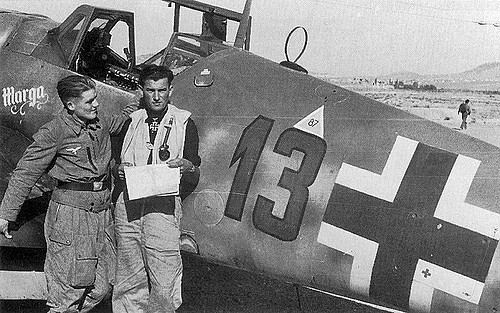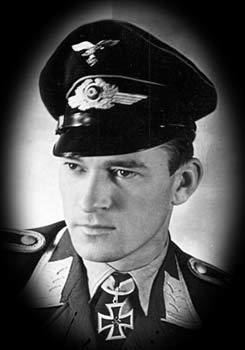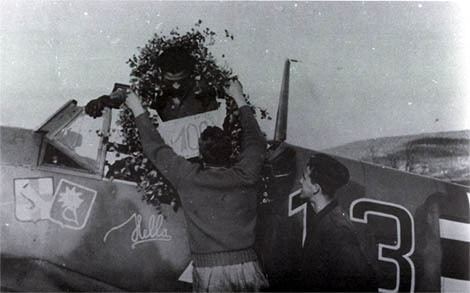Years of service 1939–44 | Name Heinrich Bartels | |
Heinrich Bartels (born 13 July 1918 in Linz, Austria – killed in action 23 December 1944 near Bad Godesberg) was a German fighter pilot in the Luftwaffe and fought during World War II. Bartels was credited with 99 victories, making him a fighter ace. A fighter ace is a military aviator credited with shooting down five or more enemy aircraft during aerial combat.
Contents

Born in Austria in 1918 and working as a baker to his late teenage years Bartels joined the Luftwaffe after Germany's union with Austria in 1938. Bartels completed his training as a pilot in 1941. He was assigned to Jagdgeschwader 26 (Fighter Wing 26—JG 26) on the Channel Front which was tasked with intercepting Royal Air Force (RAF) incursions over occupied France and Belgium. He achieved his first aerial victory in August 1941. Bartels was transferred to Jagdgeschwader 5 on the Eastern Front where he was awarded the Knight's Cross of the Iron Cross for 46 aerial victories. In 1943 Bartels moved to Jagdgeschwader 27, Afrika to serve in the Mediterranean and Balkans theatres and by the years end had 73 victories. In 1944 he returned to the Western Front and fought Normandy Campaign in June to August 1944. Bartel's personal tally rose to 96 and he was nominated for the Oak Leaves of the Knight's Cross.
On 23 December 1944, while supporting German forces in the Battle of the Bulge Bartels was shot down by United States Army Air Force (USAAF) P-47 Thunderbolts belonging to the US 56th Fighter Group after achieving his 99th aerial victory and he was posted missing in action. On 26 January 1968, 23 years later, Bartel's fighter and remains were found near Bad Godesberg, Germany.

Early life

Born in Linz, Austria, Bartels was working as a baker when Hitler came to power. Following Austria's unification with Nazi Germany in 1938, Bartels was drafted into the Luftwaffe. Bartels' wife's name was Margo, and they had one son, Heinz.
World War II
Bartels served with the Ergänzungsstaffel (Training/Supplement Squadron) of Jagdgeschwader 26 "Schlageter" from the early summer of 1941 onward, claiming his first two aerial victories, two Supermarine Spitfires, on 19 August 1941. He was transferred to the 11th squadron (11. Staffel) of Jagdgeschwader 1, the later re-designated 8 Staffel of Jagdgeschwader 5, on 27 January 1942. He claimed 47 Russian aircraft shot down in 100 combat missions on the Arctic front, 21 of which were in the month of September 1942 alone. He received the Knight's Cross of the Iron Cross (Ritterkreuz des Eisernen Kreuzes) after 46 aerial victories on 13 November 1942.
From August 1943 he served with 11 Staffel of Jagdgeschwader 27 (11./JG 27), later 15./JG 27, firstly on the Balkan front and then on Defense of the Reich(Reichsverteidigung) duties. According to Walter Schuck, Bartels was transferred to JG 27 following a court martial involving a disciplinary problem after excessive consumption of alcohol. By the end of 1943 he had increased the number of aerial victories claimed to 73. 24 these victories in 6 weeks among them four each on 25 October 1943 and 15 November 1943. He claimed 12 fighters of the United States Army Air Forces (USAAF) shot down during April and May 1944 and three times he had claimed three fighters shot down during single combat missions. On the Invasion front he claimed 11 Anglo-American fighters during five days in combat in June 1944. For these achievements he was nominated for Knight's Cross of the Iron Cross with Oak Leaves (Ritterkreuz des Eisernen Kreuzes mit Eichenlaub).
On 23 December 1944, Bartels took off for his last and fatal mission. Most likely he was shot down by P-47 Thunderbolt fighters of the USAAF 56th Fighter Group. Some 24 years later, on 26 January 1968, Bartels' Bf 109 G-10 (Werknummer 130 359—factory number) "Yellow 13" was found in Villip near Bad Godesberg. In its cockpit was Bartels' remains and his intact parachute, which is currently on display at the Deutsches Technikmuseum Berlin.
His score totalled 99 victories in some 500 combat missions, with 49 on the Eastern Front. His score included nine Spitfires, nine P-47s, eleven P-51s, and fourteen P-38s.
